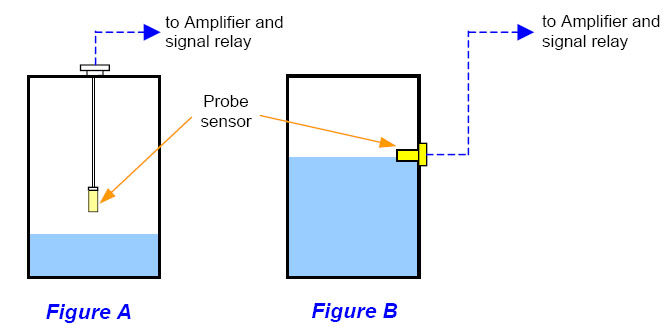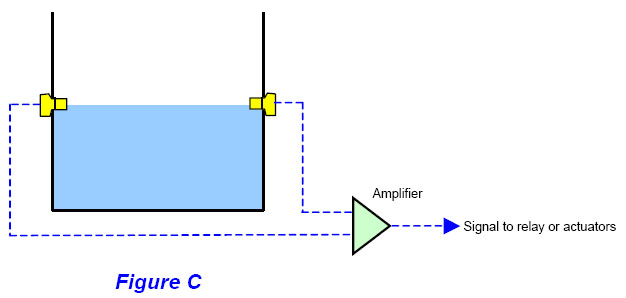Ultrasonic detectors with single sensor:

A typical single-sensor liquid level indicator is shown in figure A and Figure B
Ultrasonic detectors with two sensors:

In this system, which is generally used for dry or solids level control, one transmitting sensor creates the sonic beam, and sound waves are picked up by a receiving sensor. See figure C. This can be accomplished by a direct path or by surface and are rejected back to the receiving sensor.
For practical applications of ultrasonic measurement method, a number of factors must be considered. A few key points are:
• The speed of sound through the medium (usually air) varies with the medium’s temperature. The transducer may contain a temperature sensor to compensate for changes in operating temperature that would alter the speed of sound and hence the distance calculation that determines an accurate level measurement. Temperature compensation is provided to account for uniform temperature variances of the sound medium.
The temperature sensor is placed inside the transducer and the signal is sent to the transceiver via the transducer’s wiring. Optionally, an alternate temperature sensor can be used to provide a temperature input, rather than by using the integral temperature sensor. If the temperature of the sound medium is to remain constant, instead of using either the integral temperature compensation or the remote sensor, the desired temperature may be entered during the transceiver configuration.
• The presence of heavy foam/dust on the surface of the material can act as a sound absorbent. In some cases, the absorption may be sufficient to preclude use of the ultrasonic technique. To enhance performance where foam/dust or other factors affect the wave travel to and from the liquid surface, some models can have a beam guide attached to the transducer.
• Extreme turbulence of the liquid can cause fluctuating readings. Use of a damping adjustment in the instrument or a response delay may help overcome this problem. The transceiver provides damping to control the maximum changing rate of the displayed material level and fluctuation of the mA output signal. Damping slows down the rate of response of the display especially when liquid surfaces are in agitation or material falls into the sound path during filling.